Jurassic
The Jurassic (/dʒʊˈræs.sɪk/ juu-RASS-ik;[1] from the Jura Mountains) is a geologic period and system that spanned 56 million years from the end of the Triassic Period 201.3 million years ago (Mya) to the beginning of the Cretaceous Period 145 Mya.[note 1] The Jurassic constitutes the middle period of the Mesozoic Era, also known as the Age of Reptiles. The start of the period was marked by the major Triassic–Jurassic extinction event. Two other extinction events occurred during the period: the Pliensbachian-Toarcian extinction in the Early Jurassic, and the Tithonian event at the end;[4] neither event ranks among the "Big Five" mass extinctions, however.
| Jurassic Period 201.3–145 million years ago | |
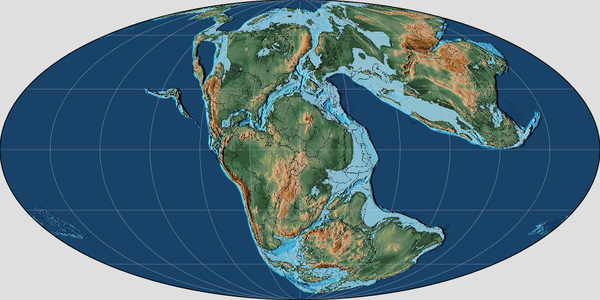 A map of the world as it appeared during the Middle Jurassic. (170 ma) | |
| Mean atmospheric O 2 content over period duration |
c. 26 vol % (130 % of modern level) |
| Mean atmospheric CO 2 content over period duration |
c. 1950 ppm (7 times pre-industrial level) |
| Mean surface temperature over period duration | c. 16.5 °C (3 °C above modern level) |
The Jurassic period is divided into three epochs: Early, Middle, and Late. Similarly, in stratigraphy, the Jurassic is divided into the Lower Jurassic, Middle Jurassic, and Upper Jurassic series of rock formations.
The Jurassic is named after the Jura Mountains in the European Alps, where limestone strata from the period were first identified. By the beginning of the Jurassic, the supercontinent Pangaea had begun rifting into two landmasses: Laurasia to the north, and Gondwana to the south. This created more coastlines and shifted the continental climate from dry to humid, and many of the arid deserts of the Triassic were replaced by lush rainforests.
On land, the fauna transitioned from the Triassic fauna, dominated by both dinosauromorph and crocodylomorph archosaurs, to one dominated by dinosaurs alone. The first birds also appeared during the Jurassic, having evolved from a branch of theropod dinosaurs. Other major events include the appearance of the earliest lizards, and the evolution of therian mammals, including primitive placentals. Crocodilians made the transition from a terrestrial to an aquatic mode of life. The oceans were inhabited by marine reptiles such as ichthyosaurs and plesiosaurs, while pterosaurs were the dominant flying vertebrates.
Etymology
The name "Jura" is derived from the Celtic root *jor via Gaulish *iuris "wooded mountain", which, borrowed into Latin as a place name, evolved into Juria and finally Jura.[5][6][7]
The chronostratigraphic term "Jurassic" is directly linked to the Jura Mountains, a mountain range mainly following the course of the France–Switzerland border. During a tour of the region in 1795,[note 2] Alexander von Humboldt recognized the mainly limestone dominated mountain range of the Jura Mountains as a separate formation that had not been included in the established stratigraphic system defined by Abraham Gottlob Werner, and he named it "Jura-Kalkstein" ('Jura limestone') in 1799.[note 3][5][6][10]
Thirty years later, in 1829, the French naturalist Alexandre Brongniart published a survey on the different terrains that constitute the crust of the Earth. In this book, Brongniart referred to the terrains of the Jura Mountains as terrains jurassiques, thus coining and publishing the term for the first time.[11]
Divisions
The Jurassic period is divided into three epochs: Early, Middle, and Late. Similarly, in stratigraphy, the Jurassic is divided into the Lower Jurassic, Middle Jurassic, and Upper Jurassic series of rock formations, also known as Lias, Dogger and Malm in Europe.[12] The separation of the term Jurassic into three sections originated with Leopold von Buch.[10] The faunal stages from youngest to oldest are:
| Upper/Late Jurassic | |
| Tithonian | (152.1 ± 4 – 145 ± 4 Mya) |
| Kimmeridgian | (157.3 ± 4 – 152.1 ± 4 Mya) |
| Oxfordian | (163.5 ± 4 – 157.3 ± 4 Mya) |
| Middle Jurassic | |
| Callovian | (166.1 ± 4 – 163.5 ± 4 Mya) |
| Bathonian | (168.3 ± 3.5 – 166.1 ± 4 Mya) |
| Bajocian | (170.3 ± 3 – 168.3 ± 3.5 Mya) |
| Aalenian | (174.1 ± 2 – 170.3 ± 3 Mya) |
| Lower/Early Jurassic | |
| Toarcian | (182.7 ± 1.5 – 174.1 ± 2 Mya) |
| Pliensbachian | (190.8 ± 1.5 – 182.7 ± 1.5 Mya) |
| Sinemurian | (199.3 ± 1 – 190.8 ± 1.5 Mya) |
| Hettangian | (201.3 ± 0.6 – 199.3 ± 1 Mya) |
Paleogeography and tectonics
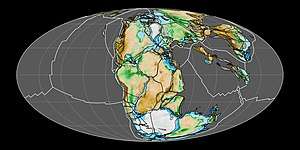


During the early Jurassic period, the supercontinent Pangaea broke up into the northern supercontinent Laurasia and the southern supercontinent Gondwana; the Gulf of Mexico opened in the new rift between North America and what is now Mexico's Yucatán Peninsula. The Jurassic North Atlantic Ocean was relatively narrow, while the South Atlantic did not open until the following Cretaceous period, when Gondwana itself rifted apart.[13] The Tethys Sea closed, and the Neotethys basin appeared. Climates were warm, with no evidence of a glacier having appeared. As in the Triassic, there was apparently no land over either pole, and no extensive ice caps existed.
The Jurassic geological record is good in western Europe, where extensive marine sequences indicate a time when much of that future landmass was submerged under shallow tropical seas; famous locales include the Jurassic Coast World Heritage Site in southern England and the renowned late Jurassic lagerstätten of Holzmaden and Solnhofen in Germany.[14] In contrast, the North American Jurassic record is the poorest of the Mesozoic, with few outcrops at the surface.[15] Though the epicontinental Sundance Sea left marine deposits in parts of the northern plains of the United States and Canada during the late Jurassic, most exposed sediments from this period are continental, such as the alluvial deposits of the Morrison Formation.
The Jurassic was a time of calcite sea geochemistry in which low-magnesium calcite was the primary inorganic marine precipitate of calcium carbonate. Carbonate hardgrounds were thus very common, along with calcitic ooids, calcitic cements, and invertebrate faunas with dominantly calcitic skeletons.[16]
The first of several massive batholiths were emplaced in the northern American cordillera beginning in the mid-Jurassic, marking the Nevadan orogeny.[17] Important Jurassic exposures are also found in Russia, India, South America, Japan, Australasia and the United Kingdom.
In Africa, Early Jurassic strata are distributed in a similar fashion to Late Triassic beds, with more common outcrops in the south and less common fossil beds which are predominated by tracks to the north.[18] As the Jurassic proceeded, larger and more iconic groups of dinosaurs like sauropods and ornithopods proliferated in Africa.[18] Middle Jurassic strata are neither well represented nor well studied in Africa.[18] Late Jurassic strata are also poorly represented apart from the spectacular Tendaguru fauna in Tanzania.[18] The Late Jurassic life of Tendaguru is very similar to that found in western North America's Morrison Formation.[18]
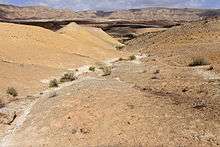 Jurassic limestones and marls (the Matmor Formation) in southern Israel
Jurassic limestones and marls (the Matmor Formation) in southern Israel- The Upper Jurassic Morrison Formation in Colorado is one of the most fertile sources of dinosaur fossils in North America
- Gigandipus, a dinosaur footprint in the Lower Jurassic Moenave Formation at the St. George Dinosaur Discovery Site at Johnson Farm, southwestern Utah
- The Permian through Jurassic stratigraphy of the Colorado Plateau area of southeastern Utah
Fauna
Aquatic and marine
During the Jurassic period, the primary vertebrates living in the sea were fish and marine reptiles. The latter include ichthyosaurs, which were at the peak of their diversity, plesiosaurs, pliosaurs, and marine crocodiles of the families Teleosauridae and Metriorhynchidae.[19] Numerous turtles could be found in lakes and rivers.[20][21]
In the invertebrate world, several new groups appeared, including rudists (a reef-forming variety of bivalves) and belemnites. Calcareous sabellids (Glomerula) appeared in the Early Jurassic.[22][23] The Jurassic also had diverse encrusting and boring (sclerobiont) communities, and it saw a significant rise in the bioerosion of carbonate shells and hardgrounds. Especially common is the ichnogenus (trace fossil) Gastrochaenolites.[24]
During the Jurassic period, about four or five of the twelve clades of planktonic organisms that exist in the fossil record either experienced a massive evolutionary radiation or appeared for the first time.[12]
 Ichthyosaurus from lower (early) Jurassic slates in southern Germany featured a dolphin-like body shape.
Ichthyosaurus from lower (early) Jurassic slates in southern Germany featured a dolphin-like body shape. Plesiosaurs like Muraenosaurus roamed Jurassic oceans.
Plesiosaurs like Muraenosaurus roamed Jurassic oceans.
Terrestrial
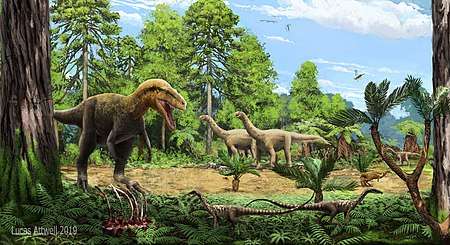
On land, various archosaurian reptiles remained dominant. The Jurassic was a golden age for the large herbivorous dinosaurs known as the sauropods—Camarasaurus, Apatosaurus, Diplodocus, Brachiosaurus, and many others—that roamed the land late in the period; their foraging grounds were either the prairies of ferns, palm-like cycads and bennettitales, or the higher coniferous growth, according to their adaptations. The smaller Ornithischian herbivore dinosaurs, like stegosaurs and small ornithopods were less predominant, but played important roles. They were preyed upon by large theropods, such as Ceratosaurus, Megalosaurus, Torvosaurus and Allosaurus, all these belong to the 'lizard hipped' or saurischian branch of the dinosaurs.[25]
During the Late Jurassic, the first avialans, like Archaeopteryx, evolved from small coelurosaurian dinosaurs. In the air, pterosaurs were common; they ruled the skies, filling many ecological roles now taken by birds,[26] and may have already produced some of the largest flying animals of all time.[27][28] Within the undergrowth were various types of early mammals, as well as tritylodonts, lizard-like sphenodonts, and early lissamphibians. The rest of the Lissamphibia evolved in this period, introducing the first salamanders and caecilians.[29]
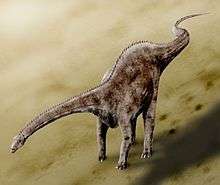 Diplodocus, reaching lengths over 30 m, was a common sauropod during the late Jurassic.
Diplodocus, reaching lengths over 30 m, was a common sauropod during the late Jurassic. Allosaurus was one of the largest land predators during the Jurassic.
Allosaurus was one of the largest land predators during the Jurassic. Stegosaurus is one of the most recognizable genera of dinosaurs and lived during the mid to late Jurassic.
Stegosaurus is one of the most recognizable genera of dinosaurs and lived during the mid to late Jurassic.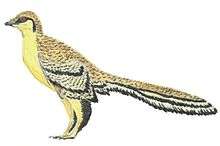
Flora
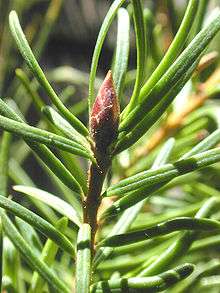

The arid, continental conditions characteristic of the Triassic steadily eased during the Jurassic period, especially at higher latitudes; the warm, humid climate allowed lush jungles to cover much of the landscape.[30] Gymnosperms were relatively diverse during the Jurassic period.[12] The Conifers in particular dominated the flora, as during the Triassic; they were the most diverse group and constituted the majority of large trees.
Extant conifer families that flourished during the Jurassic included the Araucariaceae, Cephalotaxaceae, Pinaceae, Podocarpaceae, Taxaceae and Taxodiaceae.[31] The extinct Mesozoic conifer family Cheirolepidiaceae dominated low latitude vegetation, as did the shrubby Bennettitales.[32] Cycads, similar to palm trees, were also common, as were ginkgos and Dicksoniaceous tree ferns in the forest.[12] Smaller ferns were probably the dominant undergrowth. Caytoniaceous seed ferns were another group of important plants during this time and are thought to have been shrub to small-tree sized.[33] Ginkgo plants were particularly common in the mid- to high northern latitudes.[12] In the Southern Hemisphere, podocarps were especially successful, while Ginkgos and Czekanowskiales were rare.[30][32]
In the oceans, modern coralline algae appeared for the first time.[12] However, they were a part of another major extinction that happened within the next major time period.
In popular culture
Since the early 1990s, the term Jurassic has been popularised by the Jurassic Park franchise, which started in 1990 with Michael Crichton's novel of the same title and its film adaptation, first released in 1993.
See also
References
Notes
- A 140 Ma age for the Jurassic-Cretaceous instead of the usually accepted 145 Ma was proposed in 2014 based on a stratigraphic study of Vaca Muerta Formation in Neuquén Basin, Argentina.[2] Víctor Ramos, one of the authors of the study proposing the 140 Ma boundary age, sees the study as a "first step" toward formally changing the age in the International Union of Geological Sciences.[3]
- "Ich hatte mich auf einer geognostischen Reise, die ich 1795 durch das südliche Franken, die westliche Schweiz und Ober-Italien machte, davon überzeugt, daß der Jura-Kalkstein, welchen Werner zu seinem Muschelkalk rechnete, eine eigne Formation bildete. In meiner Schrift über die unterirdischen Gasarten, welche mein Bruder Wilhelm von Humboldt 1799 während meines Aufenthalts in Südamerika herausgab, wird der Formation, die ich vorläufig mit dem Namen Jura-Kalkstein bezeichnete, zuerst gedacht." ('On a geological tour that I made in 1795 through southern France, western Switzerland and upper Italy, I convinced myself that the Jura limestone, which Werner included in his shell limestone, constituted a separate formation. In my paper about subterranean types of gases, which my brother Wilhelm von Humboldt published in 1799 during my stay in South America, the formation, which I provisionally designated with the name "Jura limestone", is first conceived.')[8]
- "[…] die ausgebreitete Formation, welche zwischen dem alten Gips und neueren Sandstein liegt, und welchen ich vorläufig mit dem Nahmen Jura-Kalkstein bezeichne." '… the widespread formation which lies between the old gypsum and the more recent sandstone and which I provisionally designate with the name "Jura limestone".'[9]
Citations
- "Jurassic". Dictionary.com Unabridged. Random House.
- Vennari et al. 2014, pp. 374-385.
- Jaramillo 2014.
- Hallam 1986, pp. 765-768.
- Hölder 1964.
- Arkell 1956.
- Rollier 1903.
- von Humboldt 1858, p. 632.
- von Humboldt 1799, p. 39.
- Pieńkowski et al. 2008, pp. 823–922.
- Brongniart 1829.
- Kazlev 2002.
- Scotese 2003.
- "Land and sea during the Jurassic". urweltmuseum.de. Archived from the original on 2007-07-14.
- "The North American Tapestry of Time and Terrain: Jurassic Rocks - 208 to 146 million years ago". nationalatlas.gov. Archived from the original on 2007-07-15.
- Stanley & Hardie 1998.
- Monroe & Wicander 1997, p. 607.
- Jacobs 1997, pp. 2-4.
- Motani 2000.
- Wings et al. 2012, pp. 925-935.
- Gannon 2012.
- Vinn & Mutvei 2009, pp. 286-296.
- Vinn, ten Hove & Mutvei 2008, pp. 295–301.
- Taylor & Wilson 2003, pp. 1-103.
- Haines 2000.
- Feduccia 1996.
- Witton, Martill & Loveridge 2010, pp. 79-81.
- Witton 2016.
- Carroll 1988.
- Haines 2000, p. 65.
- Behrensmeyer et al. 1992, p. 349.
- Behrensmeyer et al. 1992, p. 352.
- Behrensmeyer et al. 1992, p. 353.
Sources
- Arkell, W.J. (1956). Jurassic Geology of the World. Edinburgh: Oliver & Boyd.CS1 maint: ref=harv (link)
- Behrensmeyer, A.K.; Damuth, J.D.; DiMichele, W.A.; Potts, R.; Sues, H.D.; Wing, S.L., eds. (1992). Terrestrial Ecosystems through Time: the Evolutionary Paleoecology of Terrestrial Plants and Animals. Chicago: University of Chicago Press. ISBN 0-226-04154-9.CS1 maint: ref=harv (link)
- Brongniart, Alexandre (1829). Tableau des terrains qui composent l'écorce du globe ou essai sur la structure de la partie connue de la terre [Description of the Terrains that Constitute the Crust of the Earth or Essay on the Structure of the Known Lands of the Earth] (in French). Strasbourg – via Gallica.CS1 maint: ref=harv (link)
- Carroll, R. L. (1988). Vertebrate Paleontology and Evolution. New York: WH Freeman. ISBN 978-0-7167-1822-2.CS1 maint: ref=harv (link)
- Feduccia, A. (1996). The Origin and Evolution of Birds. New Haven: Yale University Press. ISBN 978-0-300-06460-5.CS1 maint: ref=harv (link)
- Gannon, Megan (31 October 2012). "Jurassic turtle graveyard found in China". cbsnews.com. Retrieved 10 October 2019.CS1 maint: ref=harv (link)
- Haines, Tim (2000). Walking with Dinosaurs: A Natural History. New York: Dorling Kindersley. ISBN 978-0-7894-5187-3.CS1 maint: ref=harv (link)
- Hallam, A. (1986). "The Pliensbachian and Tithonian extinction events". Nature. 319 (6056): 765–768. Bibcode:1986Natur.319..765H. doi:10.1038/319765a0.CS1 maint: ref=harv (link)
- Hölder, H. (1964). Jura – Handbuch der stratigraphischen Geologie (in German). IV. Stuttgart: Enke-Verlag.CS1 maint: ref=harv (link)
- Jacobs, Louis, L. (1997). "African Dinosaurs". In Currie, Phillip J.; Padian, Kevin (eds.). Encyclopedia of Dinosaurs. Academic Press.CS1 maint: ref=harv (link)
- Jaramillo, Jessica (March–April 2014). "Entrevista al Dr. Víctor Alberto Ramos, Premio México Ciencia y Tecnología 2013" (in Spanish). Vol. 17 no. 66.
Si logramos publicar esos nuevos resultados, sería el primer paso para cambiar formalmente la edad del Jurásico-Cretácico. A partir de ahí, la Unión Internacional de la Ciencias Geológicas y la Comisión Internacional de Estratigrafía certificaría o no, depende de los resultados, ese cambio.
Cite magazine requires|magazine=(help)CS1 maint: ref=harv (link) - Kazlev, M. Alan (2002). "Palaeos Mesozoic: Jurassic: The Jurassic Period". Palaeos. Archived from the original on 5 January 2006. Retrieved January 8, 2006.CS1 maint: ref=harv (link)
- Pieńkowski, G.; Schudack, M.E.; Bosák, P.; Enay, R.; Feldman-Olszewska, A.; Golonka, J.; Gutowski, J.; et al. (2008). "Jurassic". In McCann, T. (ed.). The Geology of Central Europe. Mesozoic and Cenozoic. London: Geological Society.CS1 maint: ref=harv (link)
- Rollier, L. (1903). "Das Schweizerische Juragebirge". Sonderabdruck aus dem Geographischen Lexikon der Schweiz (in German). Attinger, Neuenburg: von Gebr.CS1 maint: ref=harv (link)
- Monroe, James S.; Wicander, Reed (1997). The Changing Earth: Exploring Geology and Evolution (2nd ed.). Belmont: West Publishing Company. ISBN 0-314-09577-2.CS1 maint: ref=harv (link)
- Motani, R. (2000). "Rulers of the Jurassic Seas". Scientific American. Vol. 283 no. 6. doi:10.1038/scientificamerican1200-52.CS1 maint: ref=harv (link)
- Scotese, Christopher R. (2003). "Pangea Begins to Rift Apart". scotese.com. Retrieved 2019-10-10.CS1 maint: ref=harv (link)
- Stanley, S.M.; Hardie, L.A. (1998). "Secular oscillations in the carbonate mineralogy of reef-building and sediment-producing organisms driven by tectonically forced shifts in seawater chemistry". Palaeogeography, Palaeoclimatology, Palaeoecology. 144 (1–2): 3–19. Bibcode:1998PPP...144....3S. doi:10.1016/s0031-0182(98)00109-6.CS1 maint: ref=harv (link)
- Taylor, P.D.; Wilson, M.A. (2003). "Palaeoecology and evolution of marine hard substrate communities" (PDF). Earth-Science Reviews. 62 (1): 1–103. Bibcode:2003ESRv...62....1T. doi:10.1016/s0012-8252(02)00131-9. Archived from the original (PDF) on 2009-03-25.CS1 maint: ref=harv (link)
- Vennari, Verónica V.; Lescano, Marina; Naipauer, Maximiliano; Aguirre-Urreta, Beatriz; Concheyro, Andrea; Schaltegger, Urs; Armstrong, Richard; Pimentel, Marcio; Ramos, Victor A. (2014). "New constraints on the Jurassic–Cretaceous boundary in the High Andes using high-precision U–Pb data". Gondwana Research. 26 (1): 374–385. Bibcode:2014GondR..26..374V. doi:10.1016/j.gr.2013.07.005.CS1 maint: ref=harv (link)
- Vinn, O.; ten Hove, H.A.; Mutvei, H. (2008). "On the tube ultrastructure and origin of calcification in sabellids (Annelida, Polychaeta)". Palaeontology. 51 (2): 295–301. doi:10.1111/j.1475-4983.2008.00763.x.CS1 maint: ref=harv (link)
- Vinn, O.; Mutvei, H. (2009). "Calcareous tubeworms of the Phanerozoic" (PDF). Estonian Journal of Earth Sciences. 58 (4): 286–296. doi:10.3176/earth.2009.4.07. Gale A216178929.CS1 maint: ref=harv (link)
- von Humboldt, Alexander (1799). Ueber die unterirdischen Gasarten und die Mittel, ihren Nachteil zu vermindern, ein Beitrag zur Physik der praktischen Bergbaukunde [On the types of subterranean gases and means of minimizing their harm, a contribution to the physics of practical mining] (in German). Braunschweig: Vieweg.CS1 maint: ref=harv (link)
- von Humboldt, Alexander (1858). Kosmos (in German). 4. Stuttgart: Cotta. p. 632 – via HathiTrust.CS1 maint: ref=harv (link)
- Wings, Oliver; Rabi, Márton; Schneider, Jörg W.; Schwermann, Leonie; Sun, Ge; Zhou, Chang-Fu; Joyce, Walter G. (2012). "An enormous Jurassic turtle bone bed from the Turpan Basin of Xinjiang, China". Naturwissenschaften. 114 (11): 925–935. Bibcode:2012NW.....99..925W. doi:10.1007/s00114-012-0974-5. PMID 23086389.CS1 maint: ref=harv (link)
- Witton, Mark P.; Martill, David M.; Loveridge, Robert F. (2010). "Clipping the Wings of Giant Pterosaurs: Comments on Wingspan Estimations and Diversity". Acta Geoscientica Sinica. 31 (Supp 1): 79–81.CS1 maint: ref=harv (link)
- Witton, Mark P. (23 June 2016). "Why the giant azhdarchid Arambourgiania philadelphiae needs a fanclub". markwitton-com.blogspot.com.CS1 maint: ref=harv (link)
Further reading
- Mader, Sylvia (2004). Biology (eighth ed.).CS1 maint: ref=harv (link)
- Ogg, Jim (June 2004). Overview of Global Boundary Stratotype Sections and Points (GSSP's). International Commission on Stratigraphy. p. 17.CS1 maint: ref=harv (link)
- Stanley, S.M.; Hardie, L.A. (1999). "Hypercalcification; paleontology links plate tectonics and geochemistry to sedimentology". GSA Today. 9: 1–7.CS1 maint: ref=harv (link)
External links
| Wikimedia Commons has media related to Jurassic. |
| Look up jurassic in Wiktionary, the free dictionary. |
- Examples of Jurassic Fossils
- Jurassic (chronostratigraphy scale)
- Jurassic fossils in Harbury, Warwickshire
- Jurassic Microfossils: 65+ images of Foraminifera
- . Encyclopædia Britannica. 15 (11th ed.). 1911. With map and table.